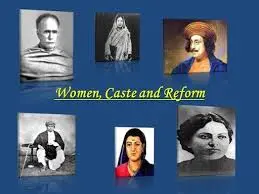Multiple Choice Questions-Women, Caste and Reform-Class 8-Social Science

1. Who founded the Brahmo Samaj?
a) Dayanand Saraswati
b) Rammohun Roy
c) Ishwarchandra Vidyasagar
d) Jyotirao Phule
Answer: b) Rammohun Roy
2. Which practice was abolished in 1829 due to efforts by reformers like Rammohun Roy?
a) Child marriage
b) Sati
c) Dowry
d) Untouchability
Answer: b) Sati
3. Which law was passed in 1856, allowing widows to remarry?
a) Widow Marriage Act
b) Hindu Marriage Act
c) Widow Remarriage Act
d) Property Inheritance Act
Answer: c) Widow Remarriage Act
4. Who founded the Arya Samaj?
a) Rammohun Roy
b) Dayanand Saraswati
c) Veerasalingam Pantulu
d) Jyotirao Phule
Answer: b) Dayanand Saraswati
5. Who wrote the book Stripurushtulna?
a) Tarabai Shinde
b) Pandita Ramabai
c) Begum Rokeya
d) Periyar
Answer: a) Tarabai Shinde
6. The Child Marriage Restraint Act was passed in:
a) 1829
b) 1929
c) 1856
d) 1919
Answer: b) 1929
7. What does the term “Sati” mean?
a) Widow
b) Virtuous woman
c) Educated woman
d) Unmarried woman
Answer: b) Virtuous woman
8. Which caste reformer founded the Satyashodhak Samaj?
a) Jyotirao Phule
b) Ishwarchandra Vidyasagar
c) Shri Narayana Guru
d) B.R. Ambedkar
Answer: a) Jyotirao Phule
9. Who argued that untouchables were the true upholders of Tamil culture?
a) Pandita Ramabai
b) Periyar
c) Rammohun Roy
d) Veerasalingam Pantulu
Answer: b) Periyar
10. What was Pandita Ramabai’s significant contribution?
a) Promoted widow remarriage
b) Founded schools for widows
c) Criticized Hinduism for oppressing women
d) All of the above
Answer: d) All of the above
11. In which year did Ambedkar lead the first temple entry movement?
a) 1919
b) 1927
c) 1935
d) 1930
Answer: b) 1927
12. What was the primary aim of the Self Respect Movement led by Periyar?
a) Promote women’s education
b) Eliminate caste-based discrimination
c) Advocate for widow remarriage
d) Abolish child marriage
Answer: b) Eliminate caste-based discrimination
13. What is the name of Jyotirao Phule’s book?
a) Gulamgiri
b) Stripurushtulna
c) The Cultivator’s Whipcord
d) Satyashodhak
Answer: a) Gulamgiri
14. The Prarthana Samaj was established in:
a) Bombay
b) Calcutta
c) Madras
d) Pune
Answer: a) Bombay
15. Who translated a Buddhist text critical of caste?
a) Ishwarchandra Vidyasagar
b) Jyotirao Phule
c) Rammohun Roy
d) Dayanand Saraswati
Answer: c) Rammohun Roy
16. The Singh Sabha movement aimed to:
a) Promote widow remarriage
b) Eliminate untouchability
c) Reform Sikhism
d) Abolish sati
Answer: c) Reform Sikhism
17. Which reformer criticized the Manusmriti for supporting caste discrimination?
a) Dayanand Saraswati
b) Periyar
c) Rammohun Roy
d) Ambedkar
Answer: b) Periyar
18. What year was the Arya Samaj founded?
a) 1830
b) 1875
c) 1856
d) 1920
Answer: b) 1875
19. The Aligarh Movement was led by:
a) Sayyid Ahmed Khan
b) Periyar
c) Rammohun Roy
d) Mumtaz Ali
Answer: a) Sayyid Ahmed Khan
20. Begum Rokeya is best known for:
a) Establishing girls’ schools
b) Writing about women’s rights
c) Criticizing conservative practices
d) All of the above
Answer: d) All of the above
21. Which movement aimed to make untouchables realize their worth?
a) Satnami Movement
b) Satyashodhak Samaj
c) Self Respect Movement
d) Temple Entry Movement
Answer: c) Self Respect Movement
22. Who led the temple entry movement?
a) Jyotirao Phule
b) B.R. Ambedkar
c) Dayanand Saraswati
d) Pandita Ramabai
Answer: b) B.R. Ambedkar
23. What did Shri Narayana Guru proclaim?
a) “One caste, one religion, one God for humankind”
b) “Unity in diversity”
c) “Equality for all”
d) “Caste is divine”
Answer: a) “One caste, one religion, one God for humankind”
24. Who among the following criticized the upper-caste dominance in the freedom struggle?
a) Periyar
b) Ambedkar
c) Both a and b
d) None of the above
Answer: c) Both a and b
25. What is the main focus of the book The Cultivator’s Whipcord?
a) Criticism of caste discrimination
b) Abolition of child marriage
c) Rights of women
d) Criticism of anti-colonial nationalism
Answer: d) Criticism of anti-colonial nationalism
***********************************************************************************
To Learn more MCQS Click Below:
***********************************************************************************
**********************************************************************************
True/False Statements
1. The Brahmo Samaj promoted idol worship.
False
2. Sati was abolished in 1829.
True
3. Ishwarchandra Vidyasagar supported child marriage.
False
4. The Arya Samaj opposed untouchability.
True
5. Pandita Ramabai was an advocate of widow remarriage.
True
6. The Prarthana Samaj was founded in Punjab.
False
7. Ambedkar experienced caste discrimination in school.
True
8. The Self Respect Movement was started by Rammohun Roy.
False
9. The book Gulamgiri was inspired by the abolition of slavery in America.
True
10. Periyar criticized Hindu scriptures like the Manusmriti.
True
***********************************************************************************
Reformers | Contributions |
Rammohun Roy | Established widows’ homes |
Ishwarchandra Vidyasagar | Founded the Satyashodhak Samaj |
Jyotirao Phule | Supported widow remarriage |
Pandita Ramabai | Abolition of Sati |
Dayanand Saraswati | Aligarh Movement |
Periyar | Advocated “one caste, one religion, one god” |
Sayyid Ahmed Khan | Founded the Arya Samaj |
Shri Narayana Guru | Started the Self Respect Movement |
Ambedkar | Promoted women’s education |
Begum Rokeya | Temple entry movement |
Answer:
Reformers | Contributions |
Rammohun Roy | Abolition of Sati |
Ishwarchandra Vidyasagar | Supported widow remarriage |
Jyotirao Phule | Founded the Satyashodhak Samaj |
Pandita Ramabai | Established widows’ homes |
Dayanand Saraswati | Founded the Arya Samaj |
Periyar | Started the Self Respect Movement |
Sayyid Ahmed Khan | Aligarh Movement |
Shri Narayana Guru | Advocated “one caste, one religion, one god” |
Ambedkar | Temple entry movement |
Begum Rokeya | Promoted women’s education |